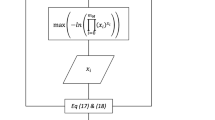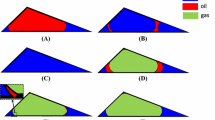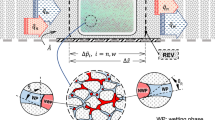Abstract
In three-phase flow, the macroscopic constitutive relations of capillary pressure and relative permeability as functions of saturation depend in a complex manner on the underlying pore occupancies. These three-phase pore occupancies depend in turn on the interfacial tensions, the pore sizes and the degree of wettability of the pores, as characterised by the cosines of the oil–water contact angles. In this work, a quasi-probabilistic approach is developed to determine three-phase pore occupancies in media where the degree of wettability varies from pore to pore. Given a set of fluid and rock properties, a simple but novel graphical representation is given of the sizes and oil–water contact angles underlying three-phase occupancies for every allowed combination of capillary pressures. The actual phase occupancies are then computed using the contact angle probability density function. Since a completely accessible porous medium is studied, saturations, capillary pressures, and relative permeabilities are uniquely related to the pore occupancies. In empirical models of three-phase relative permeability it is of central importance whether a phase relative permeability depends only on its own saturation and how this relates to the corresponding two-phase relative permeability (if at all). The new graphical representation of pore sizes and wettabilities clearly distinguishes all three-phase pore occupancies with respect to these saturation-dependencies. Different types of saturation-dependencies may occur, which are shown to appear in ternary saturation diagrams of iso-relative permeability curves as well, thus guiding empirical approaches. However, for many saturation combinations three-phase and two-phase relative permeabilities can not be linked. In view of the latter, the present model has been used to demonstrate an approach for three-phase flow modelling on the basis of the underlying pore-scale processes, in which three-phase relative permeabilities are computed only along the actual flow paths. This process-based approach is used to predict an efficient strategy for oil recovery by simultaneous water-alternating-gas (SWAG) injection.
Similar content being viewed by others
References
Baker, L. E.: 1988, Three-phase relative permeability correlations, SPE17369, in: Proceedings of the 6th SPE/DOE Symposium on Enhanced Oil Recovery, Tulsa, OK, April 1988.
Baker, L. E.: 1993, Three-phase relative permeability of water-wet, intermediate-wet and oil-wet sandstone, in: Proceedings of the 7th European IOR-Symposium, Moscow, October 1993.
Bartell, F. E. and Osterhof, H. J.: 1927, Deterlination of the wettability of a solid by a liquid, Ind. Eng. Chem. 19, 1277–1280.
Blunt, M.J.: 1999, An empirical model for three-phase relative permeability, SPE56474, In: Proceed-ings of the SPE Annual Technical Conference and Exhibition, Houston, TX, October 1999.
Fenwick, D. H. and Blunt, M. J.: 1998a, Three-dimensional modeling of three phase imbibition and drainage, Adv. Water Resour. 21, 121–143.
Fenwick, D. H. and Blunt, M. J.: 1998b, Network modeling of three-phase flow in porous media, SPE J. 3, 86–97.
Heiba, A. A., Davis, H. T and Scriven, L. E.: 1984, Statistical network theory of three-phase relative permeabilities, SPE12690, In: Proceedings of the 4th DOE/SPE Symposium on Enhanced Oil Recovery, Tulsa, OK, April 1984.
Heiba, A. A., Jerauld, G. R., Davis, H. T. and Scriven, L. E.: 1986, Mechanism-based simulation of oil recovery processes, SPE15593, In: Proceedings of the SPE Annual Technical Conference and Exhibitiotn, New Orleans, October 1986.
Hui, M.-H. and Blunt, M. J.: 2000, Pore-scale modeling of three-phase flow and the effects of wet-tability, SPE59309, In: Proceedings of the SPE/DOE Improved Oil Recovery Symposium,Tulsa, OK, April 2000.
Hustad, O. S. and Hansen, A.-G.: 1996, A consistent formulation for three-phase relative permeabil-ities and phase pressures based on three sets of two-phase data, in: S. M. Skjaeveland, A. Skauge and L. Hinderacker (eds), RUTH: A Norwegian Research Program on Improved Oil Recovery – Program Summary, Norwegian Petroleum Directorate, Stavanger.
Jerauld G. R., Rathmell J. J.: 1997, Wettability and relative permeability of Prudhoe Bay: a case study in mixed-wet reservoirs, SPE Res. Eng. 12, 58–65.
Mani, V. and Mohanty, K. K.: 1998, Pore-level network modeling of three-phase capillary pressure and relative permeability curves, SPE J. 3, 238–248.
Moulu, J.-C., Vizika, O., Egermann, P. and Kalaydjian, F.: 1999, A new three-phase relative permeab-ility model for various wettability conditions, SPE56477, in: Proceedings of the SPE Annual Technical Conference and Exhibition, Houston, TX, October 1999.
Pereira, G. G., Pinczewski, W. V., Chan, D. Y. C., Paterson, L. and Øren, P. E.: 1996, Pore-scale network model for drainage-dominated three-phase flow in porous media, Transport in Porous Media 24, 167–201.
Stone, H. L.: 1970, Probability model for estimating three-phase relative permeability, J. Pet. Tech. 20, 214–218.
Stone, H. L.: 1973, Estimation of three-phase relative permeability and residual data, J. Can. Pet. Tech., 12, 53–61.
van Dijke, M. I. J. and Sorbie K. S.: 2000a, A probabilistic model for three-phase relative permeabil-ities in simple pore systems of heterogeneous wettability, in: Proceedings of ECMOR 7, Baveno, Italy, September 2000.
van Dijke, M. I. J. and Sorbie K. S.: 2000b, The relation between interfacial tensions and wet-tability in three-phase systems: consequences for pore occupancy and relative permeability, in: Proceedings of the 6th International Symposium on Evaluation of Wettability and its Effect on Oil Recovery, Socorro, New Mexico, 27-28 September, 2000.
van Dijke, M. I. J., McDougall, S. R. and Sorbie K. S.: 2001a, Three-phase capillary pressure and relative permeability relationships in mixed-wet systems, Transport in Porous Media 44, 1–32.
van Dijke, M. I. J., Sorbie K. S. and McDougall, S. R.: 2001b, Saturation-dependencies of three-phase relative permeabilities in mixed-wet and fractionally-wet systems, Adv. Water Resour. 24, 365–384.
Zhou, D. and Blunt, M.: 1997, Effect of spreading coefficient on the distribution of light non-aqueous phase liquid in the subsurface, J. Contam. Hydrol. 25, 1–19.
Author information
Authors and Affiliations
Rights and permissions
About this article
Cite this article
van Dijke, M., Sorbie, K. An Analysis of Three-Phase Pore Occupancies and Relative Permeabilities in Porous Media with Variable Wettability. Transport in Porous Media 48, 159–185 (2002). https://doi.org/10.1023/A:1015692630733
Issue Date:
DOI: https://doi.org/10.1023/A:1015692630733




